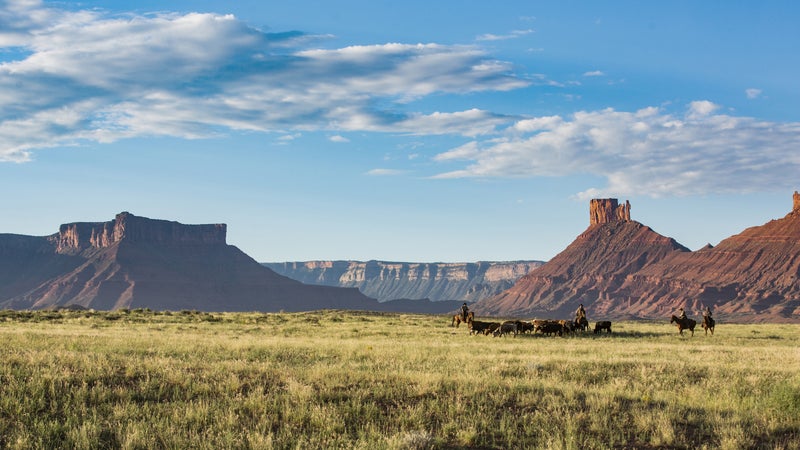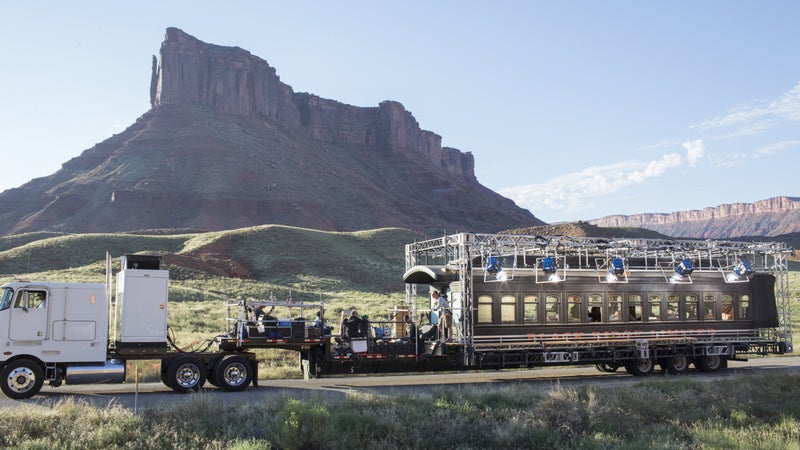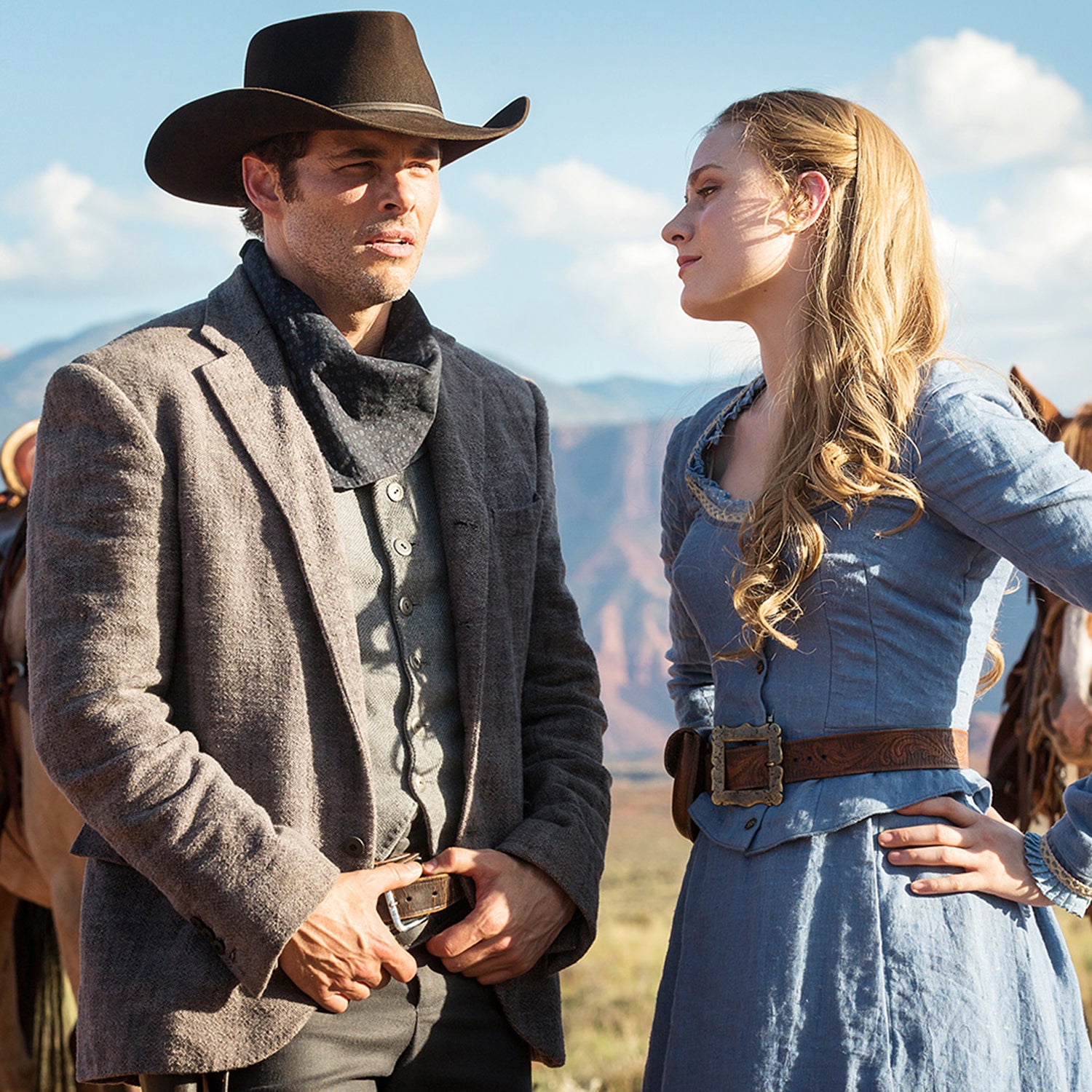On Sunday, HBO will launch , its latest attempt at another brainy, Game of Thrones-sized genre smash. The show offers an ambitious setup, loosely based on an old Michael Crichton movie: a futuristic theme park where guests pay to play as cowboys, shooting, screwing, and otherwise interacting with a crew of carefully managed robot “hosts.” It comes with a huge and excellent cast (James Marsden, Evan Rachel Wood) and tackles some classic sci-fi themes (the danger of technology, the nature of free will).
What holds Westworld together, though, is something more surprising: its landscape. In fact, many of the show’s stunning exterior shots were filmed near Moab, Utah—which means the terrain you may love from your own adventures stands as the unsung hero of this show.
In the spring of 2014, Jonathan Nolan (Christopher's brother), who created Westworld with fellow screenwriter Lisa Joy, traveled to Utah with several crewmembers to see if it might work a possible location for the show. A local scout led them through 12-hour days with at least half of that spent on foot, trekking to potential shots. But no one seemed to mind given Nolan’s obvious excitement. “I could just see the smile on his face,” says Paul Cameron, who would go on to serve as director of photography for the show’s pilot. “He knew he had found Westworld.”

Nolan also knew that filming in Utah would allow the show to tap into a specific cinematic history. When grew tired of making westerns in Monument Valley, he turned to Moab, using its stretch of the Colorado River, for instance, as the backdrop for his 1950 film Rio Grande. Following Ford’s lead, directors and their stars began making more and more westerns in the area. Henry Fonda, Maureen O'Hara,��even John Wayne starred in Moab-area movies. “TV you can make on the backlot,” Wayne of his time in Utah. “But for the big screen, for the real big-scale outdoor dramas, you have to do it where God put the West.”
Westworld isn’t just any TV, of course—it’s HBO. The network’s commitment to filming on location adds frequent jolts of pleasure to the show. Expensive swooping shots capture Utah’s gorgeous topography: the mesas and the buttes, the way the red rock formations intersect with the big blue sky.
But the location also shaped the show’s aesthetic. In the same way that Game of Thrones relies on Iceland’s moonscape to capture life north of the wall, Westworld relies on Utah’s Mars-scape to establish the grandeur of its titular theme park. On that first scouting trip, Nolan and Cameron realized they needed to imagine a world big enough to fill the empty wilderness. The park’s control center (and seedy underbelly) could be set in the steep cliffs at Dead Horse Point State Park—and could extend another 20 or 30 stories underground. “The scale of the landscape upped everything a notch for the rest of the locations,” Cameron says.
When it came time to actually film the first episode, Cameron returned to Utah for five days with a crew of about 25. The show allows itself few Hollywood tricks other than splicing together its various locations (many of Westworld's town and interior shots are filmed in California). To get those big scenic shots, Cameron had his cameramen float down the Colorado River or zoom up in helicopters. He also let the terrain inform the smallest details. One of the show’s first scenes captures Marsden sitting inside a train, riding toward the park; through the windows, you can see the actual landscape roll by. Cameron put the train car set on the back of a semi flatbed, then drove the whole thing along UT-128. “We drove the practical set up and down the highway,” Cameron says. “We did it for real.”

It was one of the shoot’s many challenges. “Practically every area was a walk-in area,” Cameron says, which means the actors and crew had to hoof it to each spot—always with equipment in tow. But efforts like that produced the tactile touches so crucial to Westworld’s success: the view out a train’s dust-smeared windows, the whir of a brothel’s player piano, and above all the grand backdrop that’s anchored western morality tales since the days of John Ford.
That authenticity will become increasingly important as the show expands its sci fi-western fusion, introducing new themes and ideas and plot twists, both inside the park and behind the scenes at the control center. It’s what makes Westworld feel simultaneously grounded and epic, meta and concrete, and all it took to pull it off was Utah’s stunning beauty and the diligence of Westworld’s crew, who didn't have much downtime to enjoy Moab on their own. A few crewmembers managed to squeeze in some mountain biking or quality time on the Colorado River, but, Cameron says with a laugh, hiking was less of a priority. “We hiked too much during the production.”


